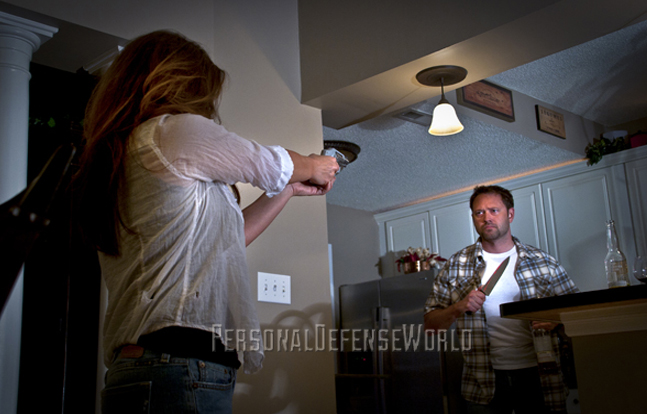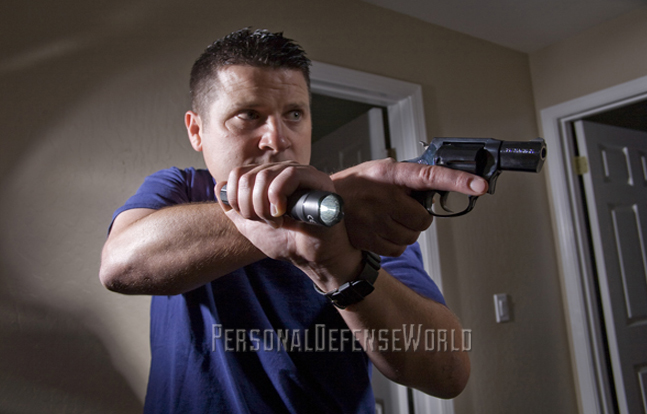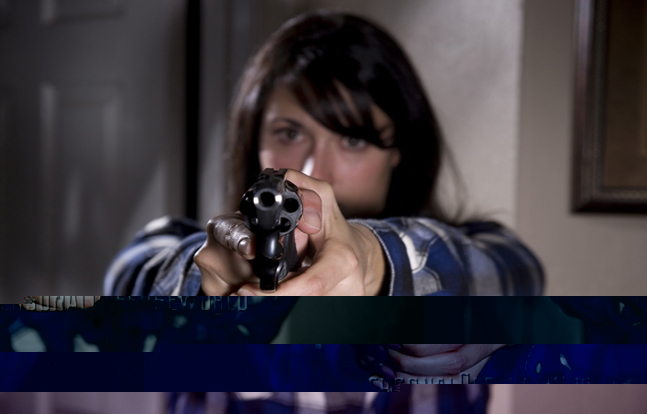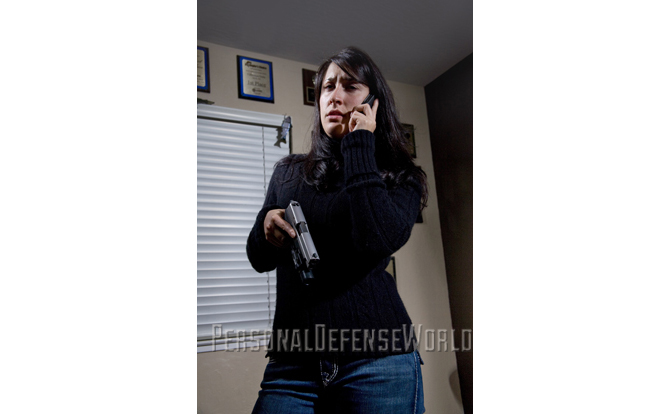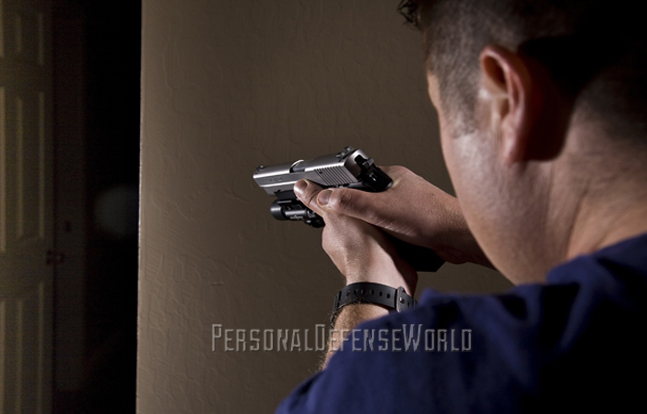Defending against a home intruder does not involve “stand your ground,” since retreat has never been required thanks to the Castle Doctrine.
Florida passed its controversial “stand your ground” law a few years ago. Prior to that, Florida had been a so-called “retreat state,” in that, when assaulted while outside his or her home, an individual was expected to retreat if safely possible before resorting to the use of deadly force in self-defense. It should be noted that nowhere in America has the legal system ever required retreat unless it could be accomplished in complete safety to oneself and other innocent persons. Florida’s new law rescinded the retreat requirement, returning the Sunshine State to a much older standard of legal principle. Now, a person could “stand his or her ground” without attempting to retreat if that individual was unlawfully attacked in a place where he or she had a right to be and was doing nothing unlawful.
Immediately, anti-gunners pounced on the law, twisting both its words and its meaning and bleating to the world that Floridians could now shoot you and get away with it if they simply said that they were afraid of you. This, of course, was not what the law actually said. But, alas, twisting the truth has never been a problem for those who are against self-defense and in favor of disarming law-abiding citizens.
Advertisement — Continue Reading Below
What was the real difference with the updated law? Attorney Andrew Branca focuses on this sort of legal issue, and in the new, excellent second edition of his book The Law of Self-Defense (lawofselfdefense.com) he writes, “The greatest value of Stand Your Ground from my perspective is that it limits the power of overreaching prosecutors. The jurors and the judge were not present at the time of the attack. They didn’t experience the fear and adrenaline, the literal fight for their life. A prosecutor can show them a sketch of the scene and ask, ‘Why didn’t the defendant just escape this way, or that way, or this third way? He didn’t have to kill that man; he could have just been the bigger person and walked away.’ This whole speech was given, of course, in the guarded safety of an air-conditioned courtroom.”
The stand-your-ground (SYG) concept is not only not new, but also not unique to Florida. Legal scholars say that there are more states that use the SYG standard than those that have a retreat requirement. Florida’s law came into the limelight, first, because of the twisted publicity of the anti-gunners and, second, because of some high-profile cases that captured national attention. The most conspicuous of those was State of Florida v. George Zimmerman, in Sanford.
The Florida Law
Let’s translate a couple of elements of the Florida law. It is too complicated to dissect and analyze in its entirety in the space available here, unfortunately.
Advertisement — Continue Reading Below
776.012 Use of force in defense of person: A person is justified in using force, except deadly force, against another when and to the extent that the person reasonably believes that such conduct is necessary to defend himself or herself or another against the other’s imminent use of unlawful force. However, a person is justified in the use of deadly force and does not have a duty to retreat if (1) he or she reasonably believes that such force is necessary to prevent imminent death or great bodily harm to himself or herself or another or to prevent the imminent commission of a forcible felony; or (2) under those circumstances permitted pursuant to s. 776.013. History.—s. 13, ch. 74-383; s. 1188, ch. 97-102; s. 2, ch. 2005-27.
Translation: This simply says that, if you’re someplace where you have a right to be and aren’t breaking the law, you don’t have to retreat before using otherwise justifiable deadly force in defense of yourself or someone else you have the right to protect.
776.032 Immunity from criminal prosecution and civil action for justifiable use of force: (1) A person who uses force as permitted in s. 776.012, s. 776.013 or s. 776.031 is justified in using such force and is immune from criminal prosecution and civil action for the use of such force, unless the person against whom force was used is a law enforcement officer, as defined in s. 943.10(14), who was acting in the performance of his or her official duties and the officer identified himself or herself in accordance with any applicable law or the person using force knew or reasonably should have known that the person was a law enforcement officer. As used in this subsection, the term “criminal prosecution” includes arresting, detaining in custody, and charging or prosecuting the defendant. (2) A law enforcement agency may use standard procedures for investigating the use of force as described in subsection (1), but the agency may not arrest the person for using force unless it determines that there is probable cause that the force that was used was unlawful. (3) The court shall award reasonable attorney’s fees, court costs, compensation for loss of income, and all expenses incurred by the defendant in defense of any civil action brought by a plaintiff if the court finds that the defendant is immune from prosecution as provided in subsection (1). History.—s. 4, ch. 2005-27.
Advertisement — Continue Reading Below
Translation: Section (1) means that, unless you shoot a cop, you can’t be arrested until the police have probable cause to believe that your actions were unlawful when you shot the attacker. Since probable cause must exist to make an arrest anyway, the fact is that this law doesn’t do anything except prevent automatic arrests after every shooting, irrespective of whether or not there is reason to believe the shooting was criminal. This is clarified in Section (2). Section (3) is an element of tort reform whose obvious legislative intent is to prevent nuisance suits and civil litigation born from revenge, greed or other unmeritorious motives. Beware, however. The wording reads, “…if the court finds that the defendant is immune from prosecution.”
Exactly how the court comes to that “finding” is not spelled out as clearly as some in the world of law would like. The Florida law provides for a hearing in SYG cases, essentially a mini-bench trial (judge only, no jury) where both sides present evidence. If the judge determines that a preponderance of evidence shows that, more likely than not, the use of force was indeed carried out in self-defense, the judge can dismiss the criminal case. This finding should suffice to satisfy Section (3) and kill the lawsuit. So should a “memorandum of closure” by the prosecutor’s office (known in Florida as the State’s Attorney’s Office) stating that the shooting was justified in defense of self or others. However, that too starts getting a little vague in actual trial practice.
Real-Life Lessons
Let’s examine some case studies, all in Florida since the new law passed. In Case One, the defendant’s lawyer chose not to go for the SYG hearing because the client was repossessing a vehicle on private property at the time of the shooting and did not strictly have a right to be where he was. Remember, SYG only works for defendants who were in a place where they had a right to be when the incident went down. In Case Two, the defendant was denied criminal immunity in an SYG hearing when the judge determined he did not, in fact, have the right to be where he was (a gated community where he did not live) at the time of the incident. In Case Three, the shooter was an invited guest who was ordered to leave by the property owner, who attacked him while he was leaving. The judge apparently didn’t think the defendant left fast enough and denied SYG protection, forcing the matter into a full-blown trial, in which the defendant was ultimately found not guilty of the homicide charge.
Advertisement — Continue Reading Below
On the civil side, consider Case Four. The burglar was shot on the homeowners’ property when he came at two members of the homeowners’ family. The State’s Attorney soon told the family’s criminal defense lawyer that he had no intention to prosecute, but he chose not to issue a memorandum of closure. That memorandum finally came roughly two years later, but while it included the elements of self-defense that made it justifiable, it did not flatly come out and categorize the shooting as a justifiable homicide. The civil suit that was quickly filed is still ongoing, awaiting a 776.032 hearing as of this writing.
Public Confusion
It has been widely stated that the SYG law allows anyone to shoot the victim of his or her choice and then blithely claim self-defense and literally “get away with murder.” When you actually read the law in question, and the case law and recommended jury instructions that accompany it, it becomes apparent to anyone who does not have a political agenda that this assertion is completely untrue.
Criminals have been killing people and falsely claiming self-defense since time immemorial. The job of the justice system is to investigate every such incident and determine whether it was justified or not. This has always been the case and will always continue to be the case, whether SYG laws are in place or not. Witness the previously cited Zimmerman case, which I’ll offer now as Case Five. The responding and investigating police did not arrest because they found no evidence to contradict the shooter’s account of a self-defense situation. Only media-driven public attention forced an arrest and subsequent trial, during which it became apparent even before the defense began its case that the investigating officers thought the defendant was telling the truth about firing in self-defense. After three arduous weeks of trial, a jury agreed, acquitting the defendant on all charges.
Advertisement — Continue Reading Below
The Tampa Bay Times newspaper has tracked SYG defenses for some time now. While they often have resulted in prosecution being dropped after a determination of self-defense—which is exactly what they were designed to do—the investigations have also sometimes shown that probable cause to believe that the shootings were criminal in nature did, in fact, exist. In those cases, of course, prosecution went forward.
If justifiable homicide rulings have increased since SYG laws went into effect, it is largely if not wholly due to the fact that, before, all homicides were lumped into the category of “gun violence” and were only later determined to be justified after a trial. Consider what I’ll call Case Six, the recent campaign by anti-gun New York Mayor Michael Bloomberg. In a traveling show where his followers solemnly read off a list of “victims of gun violence,” the list included the Boston Marathon bomber killed by police. That list also included other violent criminals killed by police in the defense of themselves and the public, all justified homicides. Historian Clayton Cramer has written of a study some time ago by a major national news magazine that listed every “gun death” during a certain period in one issue, and then went back a year later to check the results. It turned out that many of those deaths by gun had since been through the courts and ruled to be justified homicides. The SYG laws, properly applied, simply bring that finding sooner when the shootings turn out to be “clean.”
Bottom Line
The issue of SYG is too complicated to cover in depth in a magazine article. Hopefully, however, the points made previously will show how badly these laws have been misunderstood (or deliberately misinterpreted) by many in the media and elsewhere in public domain. The bottom line is that these laws have done what they were intended to do. They have reduced (though obviously not eliminated) groundless prosecutions and unmeritorious lawsuits. They have prevented good people’s lives from being destroyed after they’ve had to use force to defend themselves and their loved ones. In Florida, where, at this writing people, from U.S. Attorney General Eric Holder on down are calling for a review of SYG laws, that review has already been done. It was done by a blue-ribbon panel requested by the Governor of Florida, which included some vociferous anti-gunners. The panel recommended that the SYG law remain in place as it is now.
Advertisement — Continue Reading Below
BUY NOW! AT www.personaldefenseworld.com/subscribe/personal-home-defense/ .
